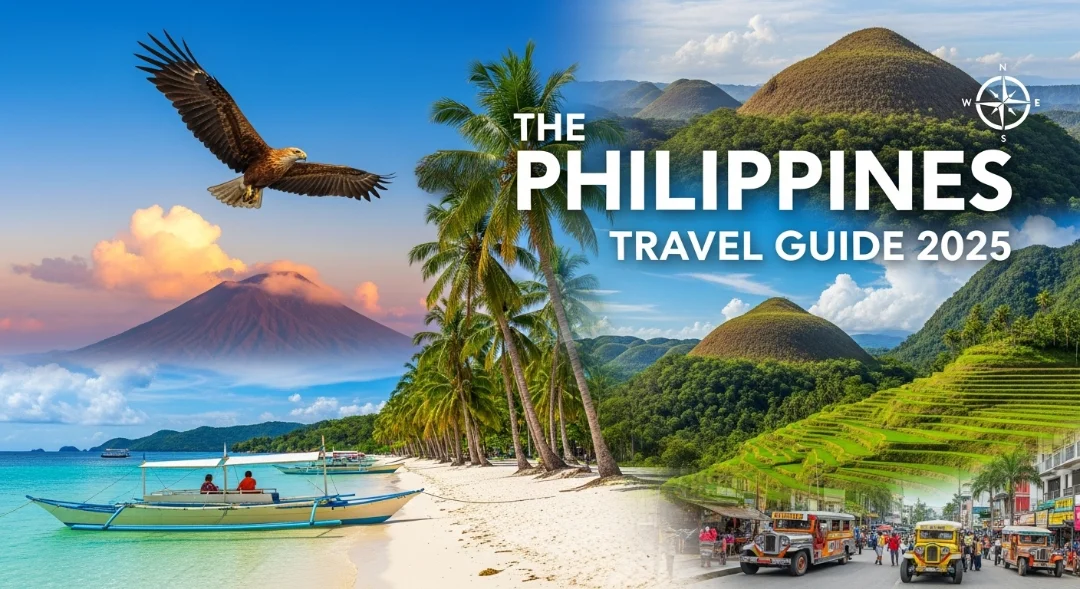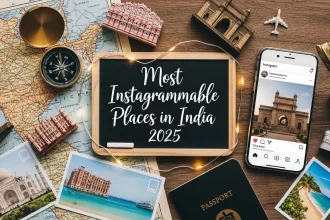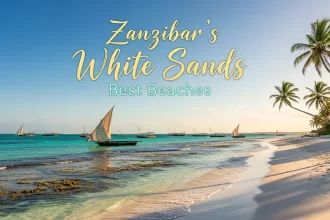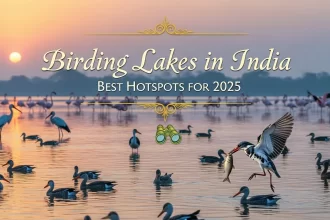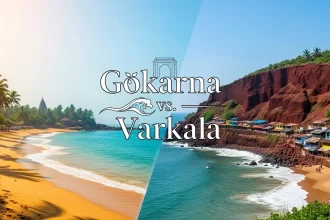Introduction: Discover Southeast Asia’s Tropical Paradise
The Philippines stands as one of Southeast Asia’s most captivating destinations, offering an incredible blend of pristine beaches, rich cultural heritage, and some of the world’s most friendly locals. Geographically referred to as the land of 7,641 islands, This comprehensive Philippines travel guide for 2025 provides essential insights and practical information for travellers planning their visit to this remarkable archipelago. Whether you’re seeking adventure, relaxation, or cultural immersion, this guide will help you navigate the country’s diverse offerings and create unforgettable memories in this tropical paradise.
10 Must-Know Facts Before You Go to the Philippines
1. It’s a Vast Archipelago of 7,641 Islands
The Philippines comprises an astonishing 7,641 islands during low tide, though only about 2,000 are inhabited. This geographical reality makes island hopping the primary mode of exploration. Travelers should plan their itinerary carefully, focusing on specific regions rather than attempting to cover too much ground.
2. Three Main Island Groups Define Your Journey
Understanding the country’s division into Luzon, Visayas, and Mindanao is crucial for planning. Luzon contains the capital Manila and mountainous north, Visayas offers the best beaches and island hopping, while Mindanao provides unique cultural experiences. This geographical knowledge helps travelers create efficient itineraries.
3. English is Widely Spoken Throughout
As an official language alongside Filipino, English is spoken by approximately 70% of the population. This makes communication remarkably easy for international visitors, eliminating significant language barriers that exist in other Southeast Asian nations.
4. Two Distinct Seasons Govern the Climate
The Philippines experiences two main seasons: the dry season (Amihan) from November to April, and the wet season (Habagat) from May to October. The best time to visit the Philippines is typically during the dry season, though shoulder months can offer good weather with fewer crowds.
5. It’s Surprisingly Budget-Friendly
Compared to many other tropical destinations, the Philippines offers excellent value. Budget travelers can enjoy comfortable accommodations, delicious Filipino food, and transportation for $30-50 per day, while mid-range travelers might budget $70-100 daily.
6. The Food is a Unique Cultural Fusion
Filipino food represents a fascinating blend of Malay, Spanish, Chinese, and American influences. Must-try dishes include adobo (marinated meat), sinigang (sour soup), and lechon (roasted pig). Street food adventures await in every city.
7. “Filipino Time” is a Cultural Reality
The concept of “Filipino Time” means that schedules often run more flexibly than in Western countries. Travelers should build buffer time into their plans, especially for transportation and tours. This relaxed approach is part of the local charm.
8. Island Hopping is the Best Way to Explore
With thousands of islands, island hopping forms the core of the Philippine travel experience. From organized tours to arranging private boats, exploring multiple islands reveals the country’s true diversity and natural beauty.
9. Incredible Biodiversity Awaits
The Philippines ranks among the world’s top biodiversity hotspots. Travelers can encounter whale sharks in Donsol, tarsiers in Bohol, and incredible marine life while diving in Palawan. This makes the country a paradise for nature lovers.
10. Genuine Hospitality Defines the Experience
Filipinos are renowned for their warm hospitality and genuine smiles. The concept of “pakikisama” (getting along) ensures that visitors typically feel welcomed and cared for throughout their journey.

The Top Places to Visit in the Philippines in 2025
1. Palawan: The Last Frontier’s Natural Wonders
Often called the country’s last frontier, Palawan boasts stunning limestone cliffs, crystal-clear lagoons, and some of the world’s best beaches. El Nido and Coron offer spectacular island hopping tours that showcase hidden lagoons and vibrant coral reefs. The underground river in Puerto Princesa remains a UNESCO World Heritage site worth exploring.
*2025 Travel Tip: Book island hopping tours in advance during peak season, and consider visiting during shoulder months (April-May or October-November) for better availability.*
2. Cebu: The Queen City of the South
Cebu offers a perfect blend of urban comforts and natural wonders. The city serves as an excellent base for exploring Kawasan Falls, Oslob’s whale sharks, and Malapascua Island’s thresher sharks. The historical sites in Cebu City provide cultural context to your adventure.
3. Boracay: Rejuvenated Paradise
After a six-month closure for rehabilitation, Boracay has returned better than ever with stricter environmental controls. White Beach remains spectacular, while new water sports and dining options continue to emerge. The island perfects the balance between development and natural preservation.
4. Bohol: Nature’s Playground
Bohol offers diverse attractions from the famous Chocolate Hills to the adorable tarsier sanctuaries. The new Bohol-Panglao International Airport has made access significantly easier. The Loboc River cruise and pristine beaches on Panglao Island complete the experience.
5. Siargao: Surfing Capital Reborn
Siargao has transformed from a sleepy surfing destination to a vibrant hotspot while maintaining its laid-back charm. Cloud 9 offers world-class surfing, while the surrounding islands provide perfect day trip opportunities. The community’s recovery from the 2021 typhoon demonstrates remarkable resilience.
6. Manila: The Historic Capital
Often used as an entry point, Manila deserves at least a couple of days exploration. Intramuros, the historic walled city, reveals Spanish colonial history, while Makati and BGC showcase modern urban development. The city’s culinary scene continues to evolve excitingly.
Planning Your 2025 Philippines Adventure
Creating Your Perfect Itinerary
A balanced 10-day itinerary might include Manila (2 days), Palawan (4 days), and Cebu (4 days). For a more comprehensive 2-week journey, add Bohol and Siargao. Consider domestic flight connections and weather patterns when planning.
Sustainable Travel Practices
The Philippines faces environmental challenges, and responsible tourism matters. Choose eco-friendly operators, avoid single-use plastics, respect marine life during snorkeling, and support local communities by eating at family-owned restaurants and buying local crafts.
Essential Travel Tips
- Purchase a local SIM card upon arrival for navigation and communication
- Carry both cash and cards, as smaller islands may not accept digital payments
- Pack reef-safe sunscreen and mosquito repellent
- Learn basic Filipino phrases like “Salamat” (Thank you) to show respect
- Always have a power bank for your devices during long travel days
Conclusion: Your Unforgettable Philippine Journey Awaits
The Philippines offers an incredible diversity of experiences that cater to every type of traveler. From the stunning natural beauty of Palawan’s lagoons to the vibrant energy of Manila’s streets, this archipelago promises memories that will last a lifetime. Use this guide as your starting point for planning an amazing adventure in 2025. The country’s perfect blend of natural wonders, rich culture, and genuine hospitality ensures that your Philippine journey will be nothing short of extraordinary. Start planning today, and prepare to discover why so many travelers return to the Philippines year after year.
Must Read: 10 Best Places to See Fall Colors 2025: Your Guide
FAQs (Frequently Asked Questions)
Q1: Is the Philippines safe for tourists?
Ans: Generally yes, especially in tourist areas. Exercise normal precautions like securing valuables and avoiding isolated areas at night. Some regions in Mindanao have travel advisories, so check current government recommendations.
Q2: What’s the best way to handle transportation between islands?
Ans: Domestic flights connect major destinations efficiently. For shorter distances, ferries are economical and scenic. Always book popular routes in advance during peak season.
Q3: How many days should I plan for my first visit?
Ans: Ten to fourteen days allows for a meaningful experience covering 2-3 regions. This provides enough time to appreciate each destination without excessive travel.
Q4: Do I need a visa for the Philippines?
Ans: Most nationalities receive a 30-day visa-free stay upon arrival. Check the latest requirements with the Philippine embassy in your country before traveling.
Thank you for trusting Outdoorkeeda as your guide for your International travel needs. 🙏

